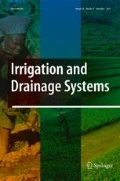Abstract
The standards for irrigation water qualityare currently provided by global andnational guidelines that are mostly basedon the assumption that threshold valuescould be applied to protect crops. Thisapproach can create problems for a largelyunrecognized group of people who make useof irrigation water for non-agriculturalpurposes. At the same time, increasingwater scarcity will lead to the need forrecycling of water in irrigated riverbasins, and the use of low qualityirrigation water. Apart from hazards ofhigh pollutant levels, a sustainabilitycriterion has to be included in the waterquality guidelines to account for long-termlow-level application of certain pollutantsthat can accumulate in the environment.Using the example of cadmium, it is arguedthat the current guidelines need to berevised and should take local factors andfuture developments into account.
Similar content being viewed by others
References
Allen H.E., Chen Y.T., Li Y., Huang C.P. & Sanders P.F. 1995. Soil partition of cadmium by column desorption and comparison to the batch adsorption measurements. Environ. Sci. Technol. 29: 1877–1891.
Al-Nakshabandi G.A., Saqqar M.M., Shatanawi M.R., Fayyad M. & Al-Horani H. 1997. Some environmental problems associated with the use of treated wastewater for irrigation in Jordan. Agricultural Water Management 34: 81–94.
Asano T. & Levine A.D. 1996. Wastewater reclamation, recycling and reuse: past, present and future. Water Science and Technology 33: 10–14.
Ault S.K. 1981. Expanding Non-agricultural Uses of Irrigation for the Disadvantaged: Health Aspects. The Agricultural Development Council Inc., New York, USA.
Ayers R.S. & Westcot D.W. 1985. Water Quality for Agriculture. FAO Irrigation and Drainage Paper 29 Rev. 1. Food and Agriculture Organization, Rome.
Bakker J.M., Barker R., Meinzen-Dick R. & Konradsen F. (Eds) 1999. Multiple Uses ofWater in Irrigated Areas: a Case Study from Sri Lanka. SWIM paper No. 8, International Water Management Institute, Colombo, Sri Lanka.
Chang A.C., Page A.L., Asano T. & Hespanhol I. 1996. Developing human health related chemical guidelines for reclaimed wastewater irrigation. Water Science and Technology 33: 463–472.
Christensen T.H. 1984. Cadmium soil sorption at low concentrations: Effect of time, cadmium load, pH and calcium. Water, Air and Soil Pollution 21: 105–114.
Christensen T.H. 1989a. Cadmium soil sorption at low concentrations: VIII. correlation with soil parameters. Water, Air and Soil Pollution 44: 71–82.
Christensen T.H. 1989b. Cadmium Soil Sorption at Low Concentrations. Technical University of Denmark. Polyteknisk forlag, Lyngby, Denmark.
Department of Water Affairs and Forestry 1996. South African Water Quality Guidelines. Volume 4, Agricultural Use: Irrigation. Second Edition. Department of Water Affairs and Forestry, Pretoria, South Africa.
EU. 1986. Limit Values for Concentrations of Heavy Metals in Soil. European Union Council directive of 12 June 1986.(86/278/EEC)
FAO. 1992. Wastewater Treatment and Use in Agriculture. FAO Irrigation and Drainage Paper No.47. Food and Agriculture Organization of United Nations, Rome.
Irwin R.J., Van Mouwerik M., Stevens L., Seese M.D. & Basham W. 1997. Environmental Contaminants Encyclopedia. National Park Service, Water Resources Division, Fort Collins, Colorado. Distributed within the U.S. Government as an electronic document.
Jensen P.K., van der Hoek W., Konradsen F. & Jehangir W.A. 1998. Domestic use of irrigation water in Punjab. In: J. Pickford (Ed) Sanitation and Water for All (pp. 297–299). Proceedings of the 24th WEDC Conference, Islamabad, Pakistan.
Lee S., Chang L., Chen C., Lui M. & Tsai L. 1998. Development of soil metal criteria to preserve groundwater quality. Water Science and Technology 38: 131–139.
Muramoto S. 1989. Heavy metal tolerance of rice plants (Oryza sativa L.) to some metal oxides at the critical levels. J. Environ. Sci. Health. 24: 559–568
Schuhmacher M., Domingo J.L., Llobet J.M. & Corbella J. 1994. Cadmium, chromium, copper, and zinc in rice and rice field soil from southern Catalonia, Spain. Bull. Environ. Contam. Toxicol. 53: 54–60.
Seckler, D., Upali A., Molden, D., de Silva, R. & Barker, R. 1998. World water demand and supply, 1990 to 2025: Scenarios and issues. Research Report 19. Colombo, Sri Lanka: International Water Management Institute
Shuval H.I., Adin A., Fattal B., Rawitz E., & Yekutiel P. 1986. Wastewater Irrigation in Developing Countries: Health Effects and Technical Solutions. World Bank Technical Paper No. 51. World Bank, Washington.
Suzuki S., Djuangshi N., Hyodo K. & Soemarwoto O. (1980). Cadmium, copper, and zinc in rice produced in Java. Arch. Environ. Contam. Toxicol. 9: 437–449.
Tjell, J.C. & Christensen T.H. 1995. Trends in cadmium contents of Danish agricultural soils. In: Christensen, B.T. & U. Trentemøller. (Eds) The Askov long-term experiments on animal manure and mineral fertilizers: 1894–1994. SP-report No 29, Danish Institute of Plants and Soil Science, Copenhagen. 113–124.
U.S. Environmental Protection Agency. 1990. Water Quality Standard for Wetlands. Office of Water Regulations and Standards (WH-585). EPA/440/S-90–011.
van der Hoek W., Konradsen F. & Jehangir W.A. 1999. Domestic use of irrigation water: health hazard or opportunity? International Journal of Water Resources Development 15: 107–119.
WHO. 1989. Health Guidelines for Use of Wastewater in Agriculture and Aquaculture. WHO Technical Report Series no.778. World Health Organization. Geneva.
WHO. 1993a. Guidelines for Drinking-Water Quality, Volume 1 Recommendations. World Health Organization. Geneva.
WHO. 1993b. Reuse of Community Wastewater: Health and Environmental Protection-Research Needs. Discussion paper 6. Community water supply and sanitation unit. World Health Organization, Geneva.
WHO. 1996. Guidelines for Drinking Water Quality, Volume 2 Health Criteria and Other Supporting Criteria.World Health Organization, Geneva
Yoder R. 1981. Non-agricultural Uses of Irrigation Systems: Past Experience and Implications for Planning and Design. The Agricultural Development Council. New York
Author information
Authors and Affiliations
Rights and permissions
About this article
Cite this article
Jensen, P.K., Matsuno, Y., van der Hoek, W. et al. Limitations of Irrigation Water Quality Guidelines from a Multiple Use Perspective. Irrigation and Drainage Systems 15, 117–128 (2001). https://doi.org/10.1023/A:1012941329395
Issue Date:
DOI: https://doi.org/10.1023/A:1012941329395




